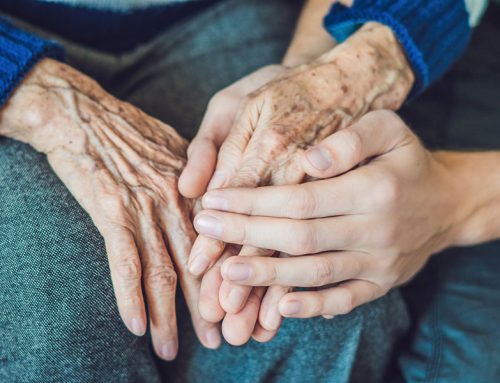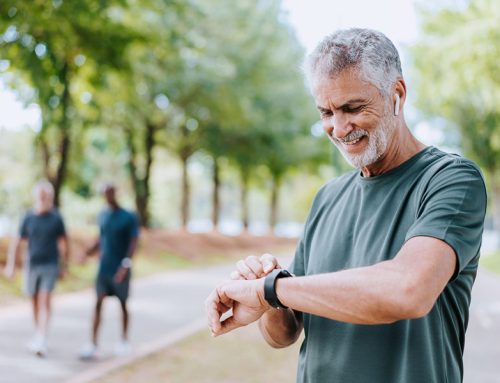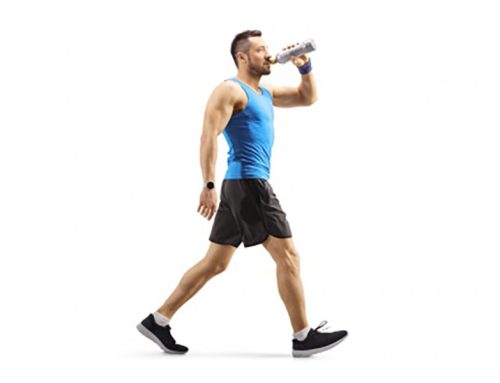There’s no sense in denying the facts or trying to sugar coat it. We are in the middle of a pandemic unlike anything our generation has ever seen, and it sucks. People are dying. Jobs have been lost. Businesses are shuttered. All the gyms are closed. Most people are under shelter-in-place and social distancing orders that will remain for at least another month and even then, it won’t be over, especially in the hard-hit hotspots.
 It makes perfect sense, however, that after we’ve accepted the outbreak for what it is – bad and out of our control – to focus on actions we do control, and alter our attitudes in the most positive way possible.
It makes perfect sense, however, that after we’ve accepted the outbreak for what it is – bad and out of our control – to focus on actions we do control, and alter our attitudes in the most positive way possible.
I’m not suggesting pollyannaism, but once you know you’re in the middle of a river of sh*t, it’s no help to keep dwelling on how much it stinks. It also does no good to be passive and let the current take you. There’s a lot we can do to control our course. We can set our sights on that far shore we want to reach and see things the way we want them to be. We can set the sails of our attitude. We can grab the oars of personal action.
In the worst tribulations or catastrophes a human could experience, even then, no one can take away your ability to think what you want to think. We can always reframe the way we look at things. As Victor Frankl wrote, “Everything can be taken from a man but one thing: The last of the human freedoms – to choose one’s attitude in any given set of circumstances, to choose one’s own way.”
In recent weeks, I’ve fielded hundreds of questions from blog readers and Inner Circle members, which revealed the concerns and anxieties our fitness community has been having during these tough times. The majority were related to the impact home isolation is having on training and nutrition plans. Established routines have been thrown into disorder. Stress is high. Avoiding comfort eating is a constant challenge. Alcohol use is on the rise. Fears of losing hard-earned muscle, strength, and fitness are being felt by almost everyone.
What should we do? That’s what today’s post is about. After hours of sharing ideas with one person at a time, I’ve now written down my answers to the 10 biggest fears and frustrations about fitness and weight control right here in one place for everyone. This is not about denying our current problems, but about accepting them, thinking optimistically, and working around them as best as we can. This is a long post, so feel free to read the whole thing sequentially, or skim and skip to the points that apply to you most.
My whole routine has been disrupted. I have no sense of structure.
I understand. So has mine. It’s upsetting when our usual routine gets interrupted. Most of us have favorite gyms, exercises, programs, equipment, and schedules. It’s jarring and frustrating when suddenly we can’t fall back to the preferred and familiar. But the old routine is gone for now. There’s a new normal for a while and we all have to embrace it or at least adapt to it. Fortunately, the solution is simple, and this might be the most important tip I can offer: Have a plan. Follow the plan. Have a schedule. Keep the schedule.
Sit down in a quiet place to review your goals (or update them if your priorities have changed), then create a new training plan based on the resources you have where you are, right now. A training plan should include exercises, sets, reps, weight and all the other standard variables. Get them on paper. A plan in your head is not a plan at all.
Next, create a schedule. Commit to the days, time, and place you will train.
Saying you will lift 3 days a week is not good enough. You must be specific. It should sound more like this: “I will do my dumbbell and body weight resistance training program every Monday, Wednesday, and Friday at 7 am in my basement fitness room. I will walk 30 minutes or more every day of the week at 6 pm, outdoors if weather is permits, otherwise I’ll use the treadmill or my bodyweight calisthenics routine.” Then get this in writing too – mark your training days on a calendar. Each workout is an appointment you pledge to keep.
I can’t do my usual workout that I know works best for me
I can’t do my usual workout either and I was pretty grumpy about it at first. I’m a lifelong gym-goer. But we can’t go to the gym, so we have to make do with what we have.
Why not look at the bright side? After years of doing the same style of workout, what’s wrong with trying a new style? Did you know that novelty alone (changing to a training routine you’ve never done before) can be a stimulus that sparks new muscle growth? If you’ve ever been on the same workout for a long time and started to feel stale and notice your progress slow down, then after changing the workout, suddenly see a new spurt of progress, then you already know how true this is.
Even if you’ve been forced to change your routine involuntaily, consider the possibility that this type of new stimulus could do you more good than harm. It could give you a new type of fitness or conditioning. It might take a load off your joints. It can also be a learning experience. I’ve learned more about body weight and resistance band training in the last three weeks than I have in my entire fitness career. It’s rather exciting.
To feel good about a change instead of upset by it, you must be open to the idea that change can be good, and be willing to try something different. Get out of your usual box and see what happens – you may be pleasantly surprised.
The only equipment I have at home is light dumbbells, and I have no room for a full rack or a barbell set, so why bother? I’ll never gain muscle without lifting heavy.
Experts agree that you need to lift heavy to maximize strength (3-6 reps is the ideal range for that), but actually, you can gain muscle lifting with light weights. For years, the ideal range for building muscle was thought to be 8 to 12 reps with moderate weights. Most people also believe that higher reps with lighter weights develop muscle endurance, but aren’t effective for building muscle size. The latest research says otherwise.
A study lead by Brad Schoenfeld PhD, and published in the Journal of Strength And Conditioning Research found that even in trained lifters, using weights so light you could do 25 to 35 reps still produced an increase in muscle mass, as long as the sets were taken close to failure. This was a big surprise to many in the bodybuilding world and it shifted the thinking about the best ways to build muscle.
The researchers concluded that if hypertrophy is the primary goal, a combination of lighter and heavier training can be beneficial for optimizing growth in all muscle fibers, instead of training exclusively with heavy loads. And if you’re stuck with a limited amount of weight, like a small dumbbell set at home, you can still make good gains, as long as you work hard enough on those high rep sets (through the burn and fatigue to the point you only have a rep or two left in the tank, if not all the way to failure).
By the way, if you don’t have much space, consider adjustable dumbbells like Powerblocks or Bowflex Select Tech– it’s like multiple dumbbells in the space of one pair.
I have zero weights at home – I can’t lift at all!
Yes you can. If you don’t have weights, then lift something else. What builds muscle is the amount of tension placed on the muscle fibers, not where the tension comes from. If any kind of weight puts enough total accumulated tension on a muscle, that muscle will grow. Lift a barbell, a dumbbell, a kettlebell, a sandbag, a full backpack, a couch, your 5-year old, your own bodyweight – lift anything, just lift something! Put your muscles under tension.
Free weights are ideal because of how you can track progressive overload so precisely, but any kind of resistance training can work. No weights? Lift your body weight – that’s what I had to do for my first two weeks of home isolation until I finally got dumbbells delivered. Here’s a simple and effective starting point for a body weight only resistance training routine:
1. Push ups (horizontal push)
2. Inverted rows (horizontal pull)
3. Bodyweight squats and or split squats (Squat)
4. Glute bridges (hip hinge)
5. Core/ab exercise of your choice
(Advanced trainees may want to do pistol squats and add pike pushups and chin ups).
For many bodyweight exercises such as squats, split squats, push ups, inverted rows, and dips, you can use a weighted backpack for added resistance. One member of our facebook group filled two buckets with water and used a rake as a barbell.
You could also try resistance bands. Don’t have any? I didn’t either, so I ordered them. Even if you prefer pumping iron, bands won’t go out of style when this is all over – you’ll have one more tool for home and travel training in the future. You could also consider body weight training with a suspension trainer like TRX. Your options for resistance training without weights are endless.
After my gym closed, I missed a whole week of training. I’m now training at home, but I’m afraid I’ll lose all the muscle I worked for years to gain
Actually you won’t lose muscle, unless you’re planning on doing zero training for multiple weeks or months while you’re stuck at home.
In a study from Baylor University, exercise scientists had subjects train for 4 weeks on and 2 weeks off, then another 4 weeks on and 2 weeks off. They were interested in testing the detraining effect of 2 week layoffs. At the end of the study, no lean body mass had been lost from taking 2 weeks off – twice in 12 weeks.
In another study published in the European Journal of Applied Physiology, subjects in one group took 3 weeks off after 6 weeks of training, then another 3 weeks off after 6 more weeks of training, then finished a final 6 week training block. The subjects in a second group trained straight through for the entire 24 weeks. You might think the continuous training group would have fared a lot better because they did 6 more weeks of training in total, but there was very little difference in results.
A small amount of muscle was lost toward the end of each 3 week break, but the lifters regained it so quickly, that over the long haul, they ended up with near the same muscle gain as the continuous training group. This study was done on beginners so we don’t know if the same thing will happen in experienced trainees. However, it does provide more evidence that a week or two off won’t cause muscle loss, and that time off from lifting can re-sensitize muscle tissue to training again.
Studies like these suggest that most fears about losing muscle after short breaks are unwarranted. In fact, short layoffs can often improve results in the long run because everyone needs extra rest and recovery at times throughout the year. When you start back up, you might find some niggling joint pains are gone, you feel mentally and physically refreshed, and you may get a new spurt of muscle gains.
This doesn’t mean that training consistency is not important or that you should take a break after every month of training. The main point is, most experts agree that you’re not going to lose muscle if you miss a week or two of training once in a while. You probably won’t see significant muscle loss until after three weeks off, and because of muscle memory, it’s easier to regain lost muscle than it is to build new muscle.
Gyms are all closed. I have no home gym. Seems like a no-win situation. Why not just take this time off and start working out when it all blows over?
You could, but I don’t recommend it. First, this kind of crisis should make us appreciate the value of our health more than ever and why we shouldn’t take it for granted. Health should be one of our highest life values and exercise one of our top priorities. It may take a ton of training to look like a bodybuilder, but fortunately, it doesn’t take much to keep the muscle you have and maintain good health, so do something, even if it’s a minimalist workout.
Second, consider that it looks like gyms will stay closed and most people will be locked down for more than a month. Remember what the studies found about detraining and muscle loss: A week or two of no resistance training – not much problem. Three weeks – you start seeing the effects of disuse. A month without training – no question, you’ll be looking smaller and less muscular. The muscle loss will take place slowly, not overnight, but it will continue to slip away with each additional week that passes.
The solution: Don’t stop training for months. Don’t even stop for multiple weeks. If you need a break go ahead and take one – preferably only a week or two of total rest. Don’t be afraid of deloading phases or short training breaks. But I wouldn’t recommend sitting this whole pandemic out, on the couch watching Netflix. If you stopped lifting completely when your gym closed, get back to some kind of resistance training at home fairly quickly with a new program. And keep reminding yourself it doesn’t take much to maintain what you already have.
I’ve been bodybuilding for years and I know how to train at home – I have dumbbells, a bench, ab wheel, swiss ball, and bands. But my fear is that this is nowhere near optimal and I won’t be able to make any real strength or size gains until I get back into the gym.
You’re right that a minimalist home gym is not optimal for advanced bodybuilding training. But first, maybe this is an occasion to put things in perspective. Thousands 0f people are dying. The size of our biceps and the amount of our bench press are perhaps not the most important things in life right now. Maybe we can shift our attitude to one of gratitude for having our health and our lives, and for being able to train at all.
It’s okay to shift into “maintenance mode” at certain times in life. Peak condition and performance can be regained easily later. Even competitive bodybuilders or powerlifters don’t need hardcore training 12 months a year – they use periodization, with blocks of training where they intentionally back off.
As a serious trained lifter, if you want to keep your gains as close to optimal as possible, then if you have room in your home and you have the budget, expand your home gym. Invest in a power rack and see if you can get one with pull up, dip, and even landmine attachments. Get a full Olympic barbell set – a good one – commercial gym quality. And if you can fit it in the budget, get a cable pulley system where you have a high and low pulley or find a multi-purpose home gym machine that has cables.
There’s no reason you can’t keep making gains at an optimal rate with a set-up like that. By sticking to basic barbell moves alone – if you have enough plates, you can build unlimited strength and muscle. If you don’t have space, expand your dumbbell set to include as much load as you need for even your heaviest presses and rows and you’ll still make solid gains. A good set of dumbbells and an adjustable bench will take you a long way.
If you have space but don’t think you have the budget, try to find a creative way to make it work (search classified sites and eBay for used equipment bargains, sell some stuff, borrow a few bucks, finance it, whatever it takes). Your investment will pay you back you for life.
I’ve trained in a gym my whole life and I love the gym – I can’t stay motivated to work out at home.
First, stop saying you can’t. It’s ok to acknowledge what you’re feeling, or state the problem once, but don’t repeat negative affirmations – that’s like asking to receive exactly what you don’t want.
I do understand. I’ve trained in gyms my whole life – I love the energy buzz in gyms, the people, and the rows and rows of equipment. Not only that, I consider the gym my sanctuary for “Me time.”But we can’t go there now, so we have to make do with what we have. The simple solution is to change how you think about it, and the easiest way do that is start asking how you can. Ask questions like, “What are the best ways I can get more motivated to work out at home?”
Here’s a place to start: Set new goals, and make sure they’re not purely focused on the scale or body composition. You may or may not want to work on losing weight or gaining muscle, and either way is fine, but set fitness and performance goals too – and a lot of them – they can be incredibly motivating and you can reach them on a day to day basis, whereas changes in body composition take more time.
How many total pushups can you do in one set? How about in one session? In one day? How long can you hold a plank? Don’t have as many pounds of free weights as usual? No problem. Instead of working on your one rep max, how many reps can you do of bench press, squats, deadlifts or rows with a given weight? Can you master a tough exercise for the first time like an unassisted pullup, handstand push up, or a pistol (one leg squat)? Can you get outside? Why not set some goals for cycling or running?
I’d rather be pumping iron in the gym too, but I found myself super motivated at home working on some fitness challenges like hitting personal records in push ups. Each week I’ve been trying to beat my 5k time. And there’s a killer hill behind the house and trying to beat my time running to the top or the total number of repeats I do in one session has been an engaging endeavor. Trying to beat personal records is addictive!
Another thought: Motivation doesn’t really come from a fancy gym. The best kind of motivation comes from within and you can conjure it up at will if you if you believe that and you give it some effort. The prerequisites are a challenging goal, a plan for reaching your goal, and good reasons why you want to achieve it – those three things give you the focus and the internal drive.
And if you still don’t feel motivated, it’s time to unleash your inner Navy SEAL, get tough, and force yourself to do it anyway. Thinking that you have to feel motivated before you can start something is a mistake. Never sit around and wait for motivation or inspiration to strike. What if it doesn’t?
No one feels motivated all the time. It may seem that way, but people are not successful because they’re naturally motivated all the time. The truth is, what makes a person successful is that he or she has developed the habit of doing what needs to be done, when it needs to be done whether they feel like doing it or not. That’s called discipline, and without this quality, you won’t get far, especially during adversity.
If it sounds hard, tell yourself that only the start is the hard part. Once you start, you often feel motivated to do more. Taking action itself is motivating, and motion creates emotion. This is how some people trick themselves into training; agreeing to start by doing something easy. Once they’re moving, they find momentum carries them the rest of the way.
You might tell yourself, “I’ll just do a set of push ups and then see how I feel.” There’s almost zero barrier to doing a single set of push ups. But the best part of all is it can feel good doing that, and then you feel like doing more. Next thing you know, you’ve done a full upper body workout. When you finish, then you feel great about yourself and you’ve begun a self-perpetuating cycle of increasing motivation.
As you see progress from one workout to the next, your results become another motivator. Worst case scenario, you do one set and call it quits for that session, but you still did something. That’s what matters. Doing anything is better than doing nothing.
I can’t stop comfort eating.
Stop saying that. Replace “I can’t” with a positive affirmation or repeat productive questions like, “Can I ‘surf the urge’ and hold out just 20 or 30 minutes because I know cravings are usually psychological and they pass? “If I still feel an urge for food, what can I eat that’s healthy and light, or can I go ahead and have a small portion of whatever I’m craving and simply fit it into my calorie budget today?” “What can I do instead of eating to make myself feel better?”
Next, work on creating a more temptation-free physical environment. Keep calorie-dense, high-sugar, high-fat refined junk and snack food out of the house. Take charge of your home. You won’t feel tempted if there are no temptations around. Out of sight, out of mind. If you have trouble with unplanned snacking, create a daily meal plan schedule in advance with the optimal calorie target for your goals, and build healthy snacks right into it. Let yourself have snacks, but only at the times of day you decide beforehand, plan what those snacks will be (nutritious choices), and keep the healthy stuff well stocked.
No foods should be forbidden. Designating foods as good or bad is not psychologically healthy and often backfires because you usually crave what you’re not allowed to have even more. Enjoy anything you want in moderation, but to help curtail intake, make it inconvenient to get. I have to be frank – I don’t have as much sympathy for people who complain about stress eating, but they keep bags of chips, jars of cookies, and pints of ice cream stockpiled in the house.
In addition, find alternative ways to cope with stress, fear, and anxiety. Food is not the answer. Food of any kind is to be enjoyed appropriately for social reasons or special occasions, but the main purpose for eating is to support your health, build your body, and fuel high performance.
And remember, food can be delicious while also nutritious. Make the effort to learn how to cook some meals that are modified for lower calories and higher protein. Here are a few favorites I’ve made in the last week that qualify in my book as classic comfort food:
Lean And Clean Mashed potatoes
I’ve been drinking too much alcohol since all this started – but it seems like the only thing that relaxes me.
It looks like this is a challenge for a lot of people right now. Nielson data said that by the end of March 2020, alcohol sales rose 55%. Tequila, gin and premixed cocktail sales spiked 75% over the previous year. Wine sales were up 66% and beer sales up 42%. Online sales were up 243%.
Alcohol may relax or soothe at first, but the feeling doesn’t last, and afterward you feel worse – physically and mentally (the hangover and the guilt). A drink or two may help some people unwind and it’s possible to fit that small amount into your weekly calorie budget without much trouble, especially if it’s not every day. Beyond that, there’s going to be a price to pay. It could show up as health problems. It could zap your energy. It could be making your body composition worse (more fat, less muscle).
Remind yourself daily what excessive alcohol does to both your health and physique and that it’s not supporting your goals. Revisit your goals and your values. If health and fitness are high on your value list, and you keep reminding yourself of that, then drinking any more than small amounts on occasion will create a clash in values, the urge will diminish, and self-control will feel easier.
When fitness is a priority, some people give up drinking and never look back. Others continue, but set boundaries. If you’re in the latter group, get a support buddy and keep each other accountable to an alcohol limit that you choose. Or even consider asking a friend or family member to commit to a no alcohol period with you, like a 30-day no booze challenge.
If you simply enjoy a drink or two now and then, that’s one thing, but think about whether there’s another reason you’re drinking. For some, it’s boredom. For many, it’s for comfort or escaping stress. But drinking is not a good way, or the only way, to fill time or relax. Ask yourself, what are the best healthy alternatives?
Could you escape into a good movie? Read good books (my favorite)? Meditate or breathe deeply? Embrace a spiritual practice? Turn on soothing music? Take a bath? Light a candle? Get outdoors if you can (another of my favorites)? Exercise? That’s a great one. The person who perceives and uses exercise or physical activity as a stress reliever is probably in the best position of all. There countless ways to release stress. Find what works for you.
A final thought
There’s one more thing we can do, beyond changing our mental attitudes and taking the most productive action we can. That is to look for what good can come out of this situation. There are two sides to everything in life, but when it comes to the good on the other side of bad, you have to acknowledge it’s there and make the effort to look for it, or else you won’t find it.
Even if we don’t see the good yet, we have to trust that in the future we’ll look back and see with hindsight that something good came out of this, or we grew in some positive way after weathering the storm. Almost everyone can agree that there’s something valuable to be learned from everything that happens to us and that overcoming adversity makes you stronger.
Train hard, expect success, and wash your hands,
– Tom Venuto
Scientific References:
Hwang, The Effects of Short-Term Detraining and Subsequent Retraining on Body Composition and Muscle Performance in Males Consuming a Whey Protein or Carbohydrate Supplement, Intl J Exer Sci, vol 2: 8, 2016.
Ogasaware R,et al, Comparison of muscle hypertrophy following 6-months of continuous and periodic strength training. Eur J Appl Physiolo, 113(4): 975-985, 2012.
Schoenfeld BJ, Peterson MD, Ogborn D, Contreras B, Sonmez GT. Effects of Low- vs. High-Load Resistance Training on Muscle Strength and Hypertrophy in Well-Trained Men. J Strength Cond Res. 29(10):2954-63. 2015






Tom,
This was, hands down, one of the best newsletters I have read in a long time. Positive. Supportive (but in a firm, no BS way). I read the entire thing in one sitting, despite its length. Absolutely time well spent. I wrapped up this column totally pumped for tomorrow’s workout. And yes, I too have been struggling with being housebound—I hate it (total Type A here. I do not do well when I have to ‘sit still ;)) I am also a daily gym goer. Fortunately for me, as someone who used to travel a lot for business, I learned many great tricks and Plan B ways of somehow getting in my workouts. Everything you say here totally resonates. Positive attitude and a bit of a ‘gitterdone’ MacGyver mindset can help overcome pretty much anything. THANK YOU!!
Thanks for posting Gary – appreciate your feedback, and glad to hear you’re pumped for your next workout.
Dear Tom,
Very well written article. Real life challenges, real life answers. One of my very favorite.